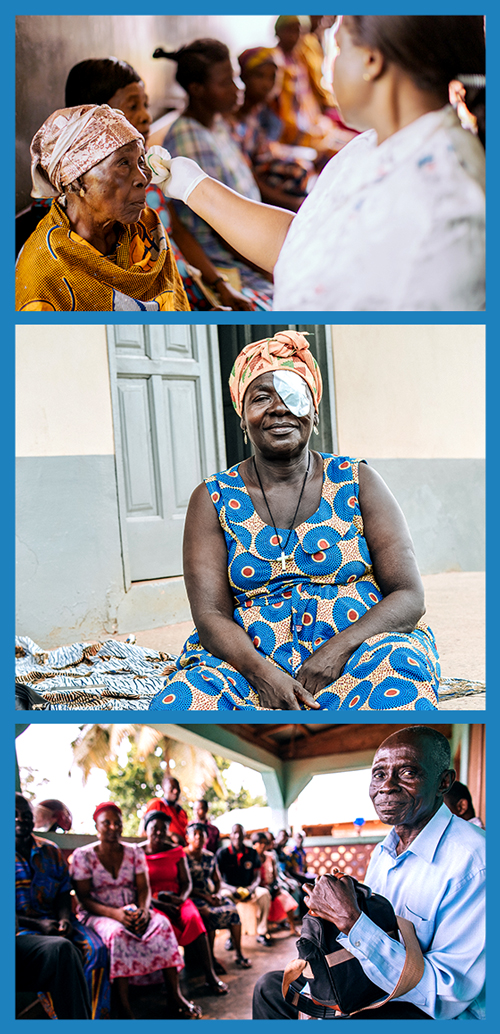The Gift of Sight Campaign
October 11, 2018
Imagine closing your eyes for a full day. How hard it would be to work, to interact with those around you. Now imagine what this must be like for the 39 million people around the world who are without sight every day. Even though 80% of global blindness is thought to be reversible or preventable with early diagnosis, a lack of screening and treatment in many countries sadly means the number of people affected worldwide is expected to triple to 115 million by 2050.

At Halma, Keeler's parent company, we’ve been working to try to tackle the problem of preventable blindness for many years. A number of our family of companies – familiar to the eyecare profession as our brands like Volk, Keeler, Medicel, MST, and Visiometrics – specialize in making equipment for ophthalmologists, opticians and optometrists to monitor the health of the eye and enable treatments to be carried out. We also partner with charities like the Himalayan Cataract Project (HCP) who work in countries where access to affordable eye care is harder to come by. We provide their volunteers with the tools and training to spot dangerous conditions like glaucoma before it is too late, supporting them to save the sight of thousands.
But we are keen to do more. We see our wider role as a technology company as growing a safer, cleaner, healthier future for everyone, every day, and this year, on World Sight Day, Halma is embarking on a campaign to do more towards the eradication of preventable blindness. We know this problem is too big for any one organization – commercial or philanthropic – to solve alone or overnight. We are starting with a series of steps, which we hope will build over time.
The first crucial step is raising awareness of a problem which is often taken for granted in more affluent countries, where healthcare is available to all. To help address this we have commissioned a new documentary film to highlight the life-changing work that HCP and others are doing in Ghana. It captures, more vividly than words ever could, the moment when eye surgery rescues someone’s sight – as well as giving a sense of the immense scale of the challenge in bringing world class eye care to the many rural communities in Africa who need it most.
The second step is taking action – both in our own back yard and by partnering with others globally. Today Halma is launching a program to encourage its own staff around the world to get their eyes tested more regularly. Our eye equipment can spot potential problems in eye health but also in other areas of the body. For each employee who gets their eyes screened, Halma will donate to HCP. Employees will have an opportunity to donate directly to HCP too. Our ambition is to test as many employees as possible by the spring and raise upwards of $200,000 for HCP.
Our businesses range from providing safety sensors for factories, elevators and trains through to the environmental monitoring of water and air quality, but what links them is a belief that technological innovation is central to helping people and the planet adapt to the challenges of the 21st century. The same is true in eye care, where without doubt, the most useful thing we can do to help end preventable blindness is continue developing new and better ways of monitoring eye health.
At Volk Optical, for example, our engineers are developing new, more portable, digital imaging devices that can carry out tests for preventable eye conditions far away from developed towns and cities. With the right training and software, these are useful not just to specialised eyecare professionals, like optometrists and ophthalmologists, but may also be useful in a primary healthcare settings to flag up cases that need urgent follow-up. Some of these cameras, like Volk’s Pictor Plus®, can be used to examine the retina at the back of the eye without it needing to be dilated – another big advantage in non-specialised settings and helpful in spotting the damage caused by the growing worldwide problem of diabetes.
The technology has come a long way since Dr David Volk first developed specialised “aspheric” lenses for examining the eye in the 1950s. Today this Ohio-based multinational sees digital imaging and artificial intelligence on the verge of transforming screening, diagnosis and treatment.
Similarly, Keeler has been making ophthalmoscopes to measure eyes for over a hundred years but is now working its Accutome product line to develop new methods using ultrasound. It has also just launched a new handheld tonometer device called a Tonocare™ which measures pressure in the eye and can help indicate conditions like glaucoma.
Over time, the combination of our portable devices and the work of partners who are developing computer algorithms to interpret results has the potential of transforming the way tests are carried out in rural areas – allowing results to be uploaded wirelessly and analysed by algorithms or in reading centres far away from the patient.
Each of our businesses are part of a far larger community of healthcare professionals and scientists around the world. Working together, we want to do our bit to ensure that everyone has a right to sight.
Written by Adam Meyers - Chief executive of Halma’s medical & environmental sector
